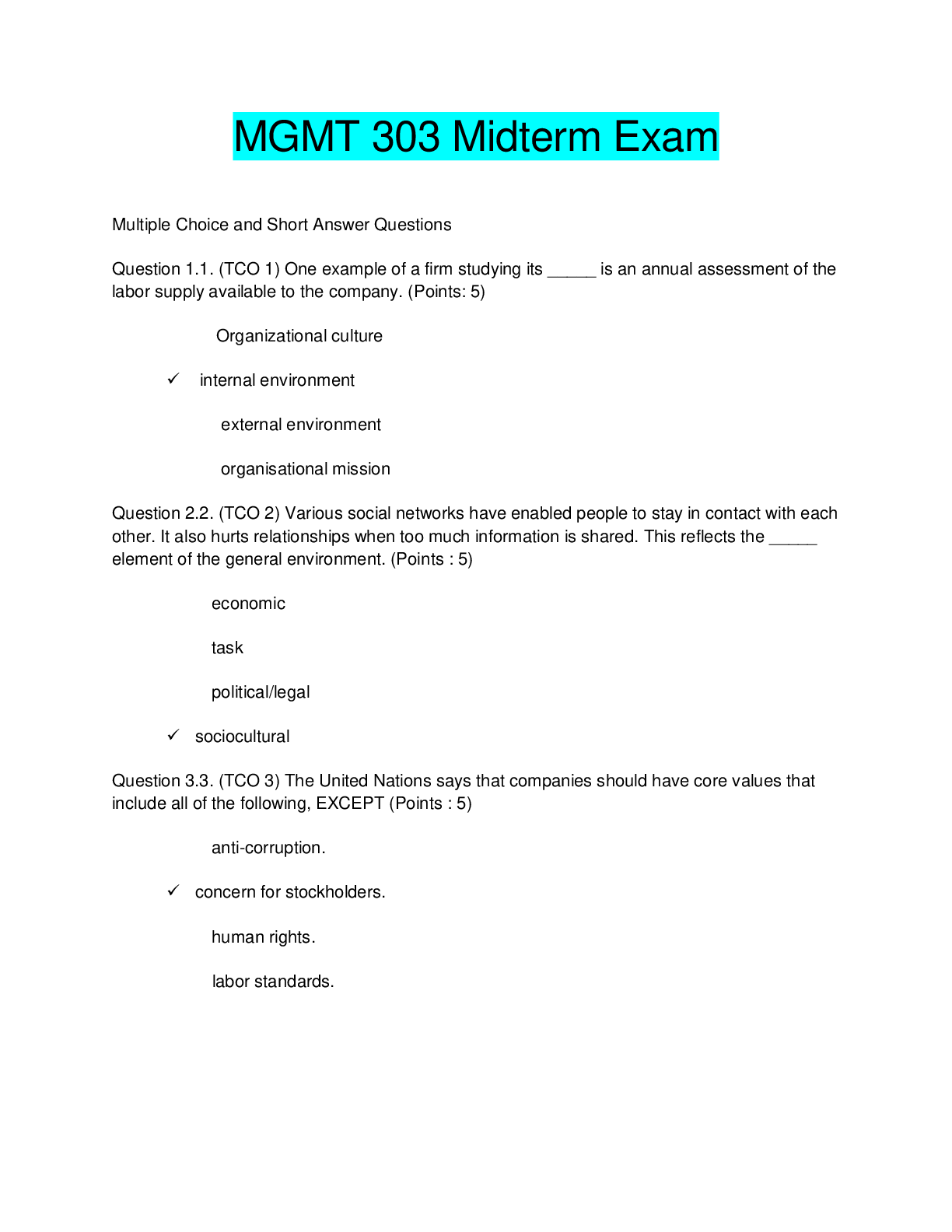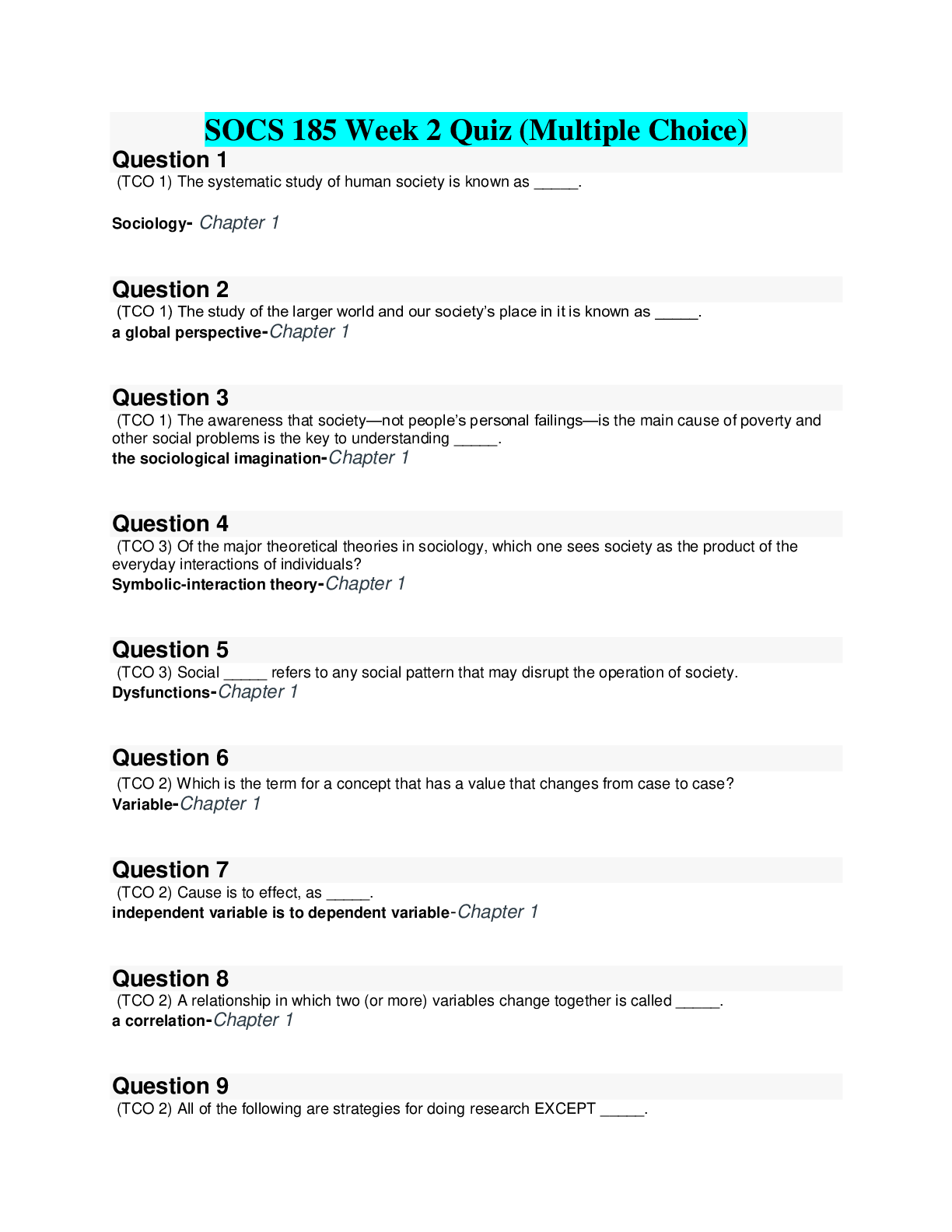NURSING 200: Comprehensive Exam 2. All answers correct. 100%.
Document Content and Description Below
Comprehensive Exam 27 A nurse, performing an assessment of a client who has been admitted to the hospital with suspected silicosis, is gathering both subjective and objective data. Which question by ... the nurse would elicit data specific to the cause of this disorder? A. "Do you chew tobacco?" B. "Do you smoke cigarettes?" C. "Have you ever worked in a mine?" D. "Are you frequently exposed to paint products?" 28 A physician prescribes a dose of morphine sulfate 2.5 mg stat to be administered intravenously to a client in pain. The nurse preparing the medication notes that the label on the vial of morphine sulfate solution for injection reads “4 mg/mL.” How many milliliters (mL) must the nurse draw into a syringe for administration to the client? Type the answer in the space provided. Answer: mL Responses: "1, .625, 0.625" 29 A client undergoing therapy with carbidopa/levodopa (Sinemet) calls the nurse at the clinic and reports that his urine has become darker since he started taking the medication. The nurse should tell the client: A. To call his physician B. That he needs to drink more fluids C. That this is an occasional side effect of the medication D. That this may be a sign of developing toxicity of the medication 30 A client with myasthenia gravis is taking neostigmine bromide (Prostigmin). The nurse determines that the client is gaining a therapeutic effect from the medication after noting: A. Bradycardia B. Increased heart rate C. Decreased blood pressure D. Improved swallowing function 31 A nurse is assessing a client who has been taking amantadine hydrochloride (Symmetrel) for the treatment of Parkinson's disease. Which finding from the history and physical examination would cause the nurse to determine that the client may be experiencing an adverse effect of the medication? A. Insomnia B. Rigidity and akinesia C. Bilateral lung wheezes D. Orthostatic hypotension 32 A nurse who will be staffing a booth at a health fair is preparing pamphlets containing information regarding the risk factors for osteoporosis. Which of the following risk factors does the nurse include in the pamphlet?Select all that apply. A. Smoking B. A high-calcium diet C. High alcohol intake D. White or Asian ethnicity E. Participation in physical activities that promote flexibility and muscle strength 33 A nurse is providing instruction to a client with osteoporosis regarding appropriate foods to include in the diet. The nurse tells the client that one food item high in calcium is: A. Corn B. Cocoa C. Peaches D. Sardines 34 A nurse is providing information to a client with acute gout about home care. Which of the following measures does the nurse tell the client to take? Select all that apply. A. Drinking 2 to 3 L of fluid each day B. Applying heat packs to the affected joint C. Resting and immobilizing the affected area D. Consuming foods high in purines E. Performing range-of-motion exercise to the affected joint three times a day 35 A nurse is gathering subjective and objective data from a client with suspected rheumatoid arthritis (RA). Which early manifestations of RA would the nurse expect to note? Select all that apply. A. Fatigue B. Anemia C. Weight loss D. Low-grade fever E. Joint deformities 36 A nurse is reviewing the medical record of a client with a suspected systemic lupus erythematosus (SLE). Which manifestations of SLE would the nurse expect to find noted in the client’s medical record? Select all that apply. A. Fever B. Vasculitis C. Weight gain D. Increased energy E. Abdominal pain 37 A nurse is providing dietary instructions to a client who is taking tranylcypromine sulfate (Parnate). Which of the following foods does the nurse tell the client to avoid while she is taking this medication? Select all that apply. A. Beer B. Apples C. Yogurt D. Baked haddock E. Pickled herring F. Roasted fresh potatoes 38 The blood serum level of imipramine is determined in a client who is being treated for depression with Tofranil-PM. The laboratory test indicates a concentration of 250 ng/mL. On the basis of this result, the nurse should: A. Contact the physician B. Hold the next dose of imipramine C. Document the laboratory result in the client's record D. Have another blood sample drawn and ask the laboratory to recheck the imipramine level 39 A nurse provides instructions to a client who has been prescribed lithium carbonate (Lithobid) for the treatment of bipolar disorder. Which of these statements by the client indicate a need for further instruction? Select all that apply. A. "I need to avoid salt in my diet." B. "It’s fine to take any over-the-counter medication with the lithium." C. "I need to come back the clinic to have my lithium blood level checked." D. " I should drink 2 to 3 quarts of liquid every day." E. “Diarrhea and muscle weakness are to be expected, and if these occur I don’t need to be concerned.” 40 A client who is taking lithium carbonate (Lithobid) complains of mild nausea, voiding in large volumes, and thirst. On assessment, the nurse notes that the client is complaining of mild thirst. On the basis of these findings, the nurse should: A. Contact the physician B. Document the findings C. Institute seizure precautions D. Have a blood specimen drawn immediately for serum lithium testing 41 A client with agoraphobia will undergo systematic desensitization through graduated exposure. In explaining the treatment to the client, the nurse tells the client that this technique involves: A. Having the client perform a healthy coping behavior B. Having the client perform a ritualistic or compulsive behavior C. Providing a high degree of exposure of the client to the stimulus that the client finds undesirable D. Gradually introducing the client to a phobic object or situation in a predetermined sequence of least to most frightening 42 A nurse is caring for a client who has just undergone esophagogastroduodenoscopy (EGD). The client says to the nurse, "I’m really thirsty — may I have something to drink?" Before giving the client a drink, the nurse should: A. Check the client's vital signs B. Check for the presence of a gag reflex C. Assess the client for the presence of bowel sounds D. Ask the client to gargle with a warm saline solution 43 A nurse is developing a plan of care for a pregnant client with sickle-cell disease. Which concern does the nurse recognize as the priority? A. Inability to cope B. Decreased nutrition C. Decreased fluid volume D. Inability to tolerate activity 44 A nurse is preparing a pregnant client in the third trimester for an amniocentesis. The nurse explains to the client that amniocentesis is often performed during the third trimester to determine: A. The sex of the fetus B. Genetic characteristics C. An accurate age for the fetus D. The degree of fetal lung maturity 45 A nurse provides instruction to a pregnant woman about foods containing folic acid. Which of these foods does the nurse tell the client to consume as sources of folic acid? Select all that apply. A. Bananas B. Potatoes C. Spinach D. Legumes E. Whole grains F. Milk products 46 A nurse caring for a client with preeclampsia prepares for the administration of an intravenous infusion of magnesium sulfate. Which of the following substances does the nurse ensure is available at the client's bedside? A. Vitamin K B. Protamine sulfate C. Potassium chloride D. Calcium gluconate 47 A nurse is monitoring a client receiving terbutaline (Brethine) by intravenous infusion to stop preterm labor. The nurse notes that the client's heart rate is 120 beats/min and that the fetal heart rate is 170 beats/min. The appropriate action by the nurse is: A. Contacting the physician B. Documenting the findings C. Continuing to monitor the client D. Increasing the rate of the infusion 48 A nurse provides home care instructions to a client with mild preeclampsia. The nurse tells the client that: A. Sodium intake is restricted B. Fluid intake must be limited to 1 quart each day C. Urine output must be measured and that the physician should be notified if output is less than 500 mL in a 24-hour period D. Urinary protein must be measured and that the physician should be notified if the results indicate a trace amount of protein 49 A nurse is monitoring a hospitalized client who is being treated for preeclampsia. Which items of the following information elicited during the assessment indicate that the condition has not yet resolved? Type the option number that is the answer. Answer: Responses: "1"____ Nursing Progress Notes 1. Hyperreflexia is present. 2. Urinary protein is not detectable. 3. Urine output is 45 mL/hr. 4. Blood pressure is 128/78 mm Hg. 50 A nurse is caring for a client who sustained a missed abortion during the second trimester of pregnancy. For which finding indicating the need for further evaluation does the nurse monitor the client? A. Spontaneous bruising B. Decrease in uterine size C. Urine output of 30 mL/hr D. Brownish vaginal discharge 51 A client is receiving an intravenous infusion of oxytocin (Pitocin) to stimulate labor. The nurse monitoring the client notes uterine hypertonicity and immediately: A. Stops the oxytocin infusion B. Checks the vagina for crowning C. Encourages the client to take short, deep breaths D. Increases the rate of the oxytocin infusion and calls the physician 52 A nurse is monitoring a pregnant woman in labor and notes this finding on the fetal-monitor tracing (see figure). Which of the following actions should the nurse take as a result of this observation? A. Repositioning the mother B. Documenting the finding C. Notifying the nurse-midwife D. Taking the mother's vital signs 53 A client with cervical cancer who is undergoing chemotherapy with cisplatin (Platinol). For which adverse effect of cisplatin will the nurse assess the client? A. Nausea B. Bloody urine C. Hearing loss D. Electrocardiographic changes 54 A nurse is monitoring a pregnant client with suspected partial placenta previa who is experiencing vaginal bleeding. Which of the following findings would the nurse expect to note on assessment of the client? A. Painful vaginal bleeding B. Sustained tetanic contractions C. Complaints of abdominal pain D. Soft, relaxed, nontender uterus [Show More]
Last updated: 2 years ago
Preview 1 out of 7 pages
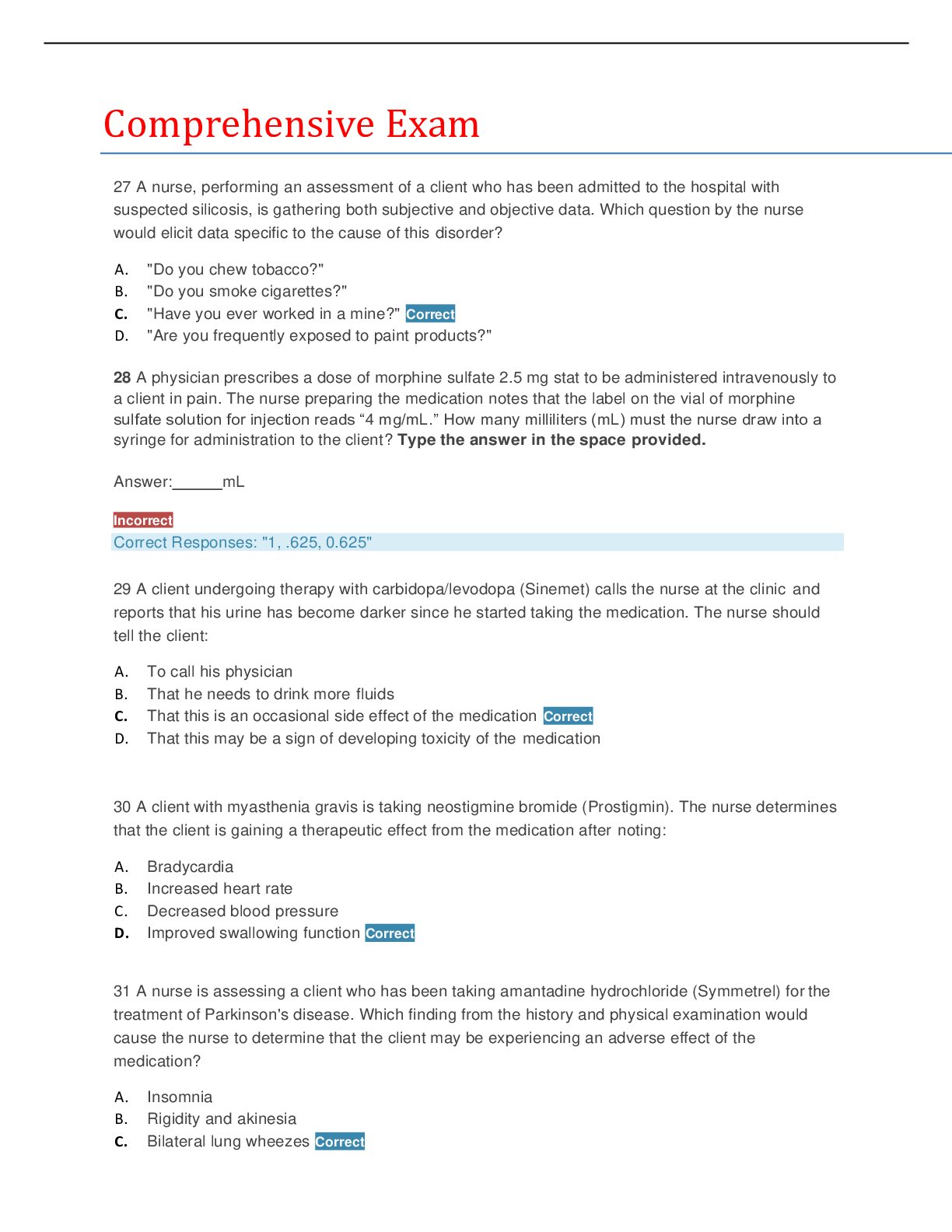
Buy this document to get the full access instantly
Instant Download Access after purchase
Buy NowInstant download
We Accept:

Reviews( 0 )
$9.00
Can't find what you want? Try our AI powered Search
Document information
Connected school, study & course
About the document
Uploaded On
Aug 20, 2020
Number of pages
7
Written in
Additional information
This document has been written for:
Uploaded
Aug 20, 2020
Downloads
0
Views
231

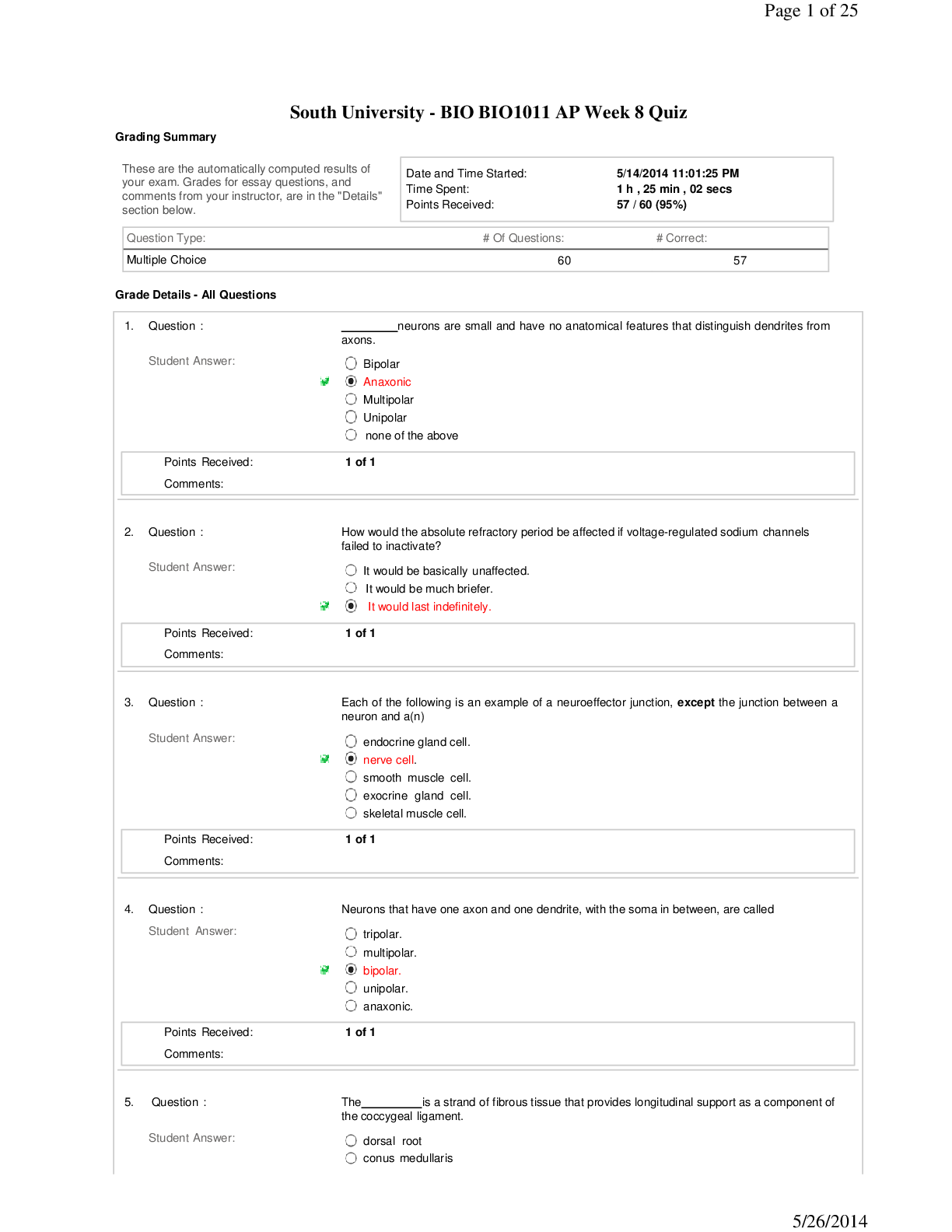
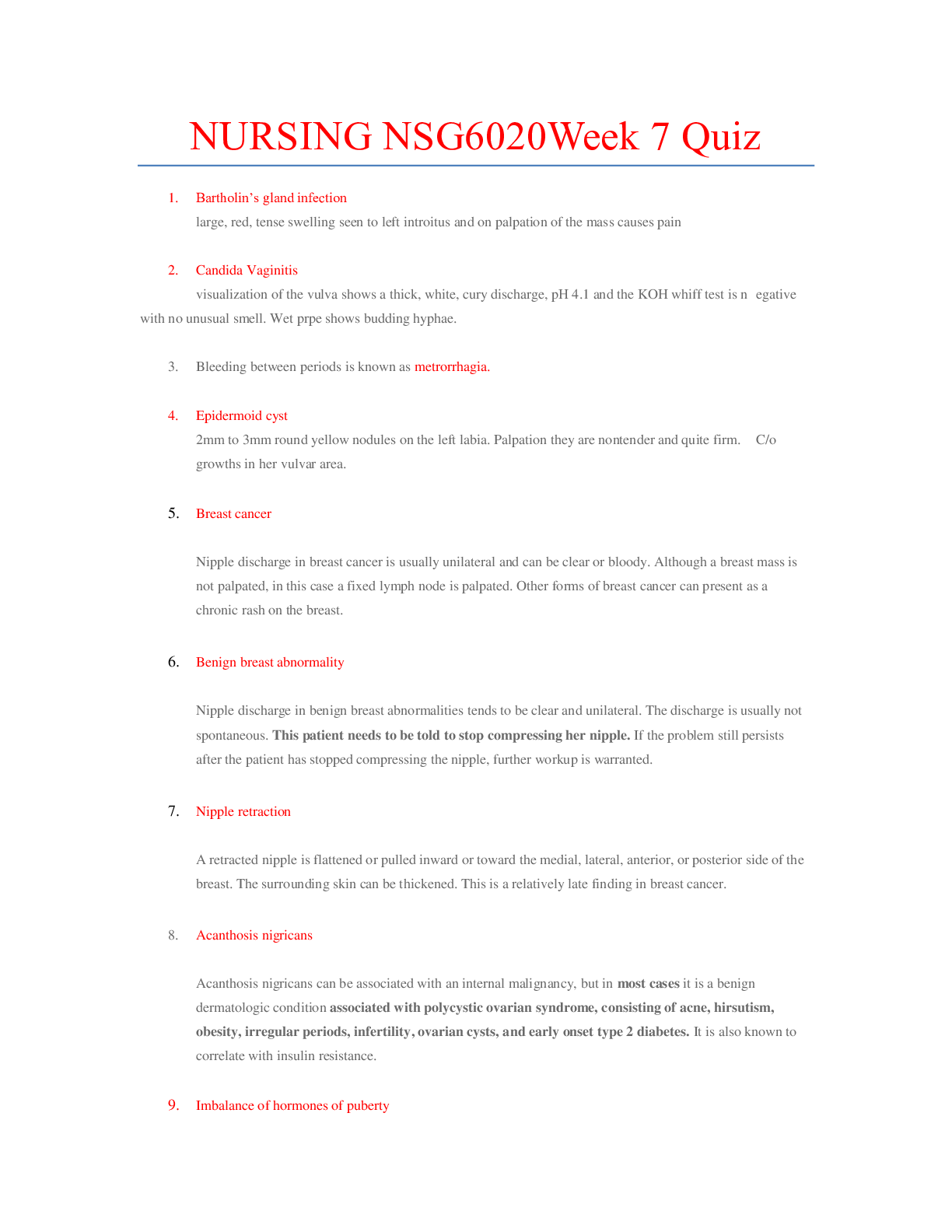
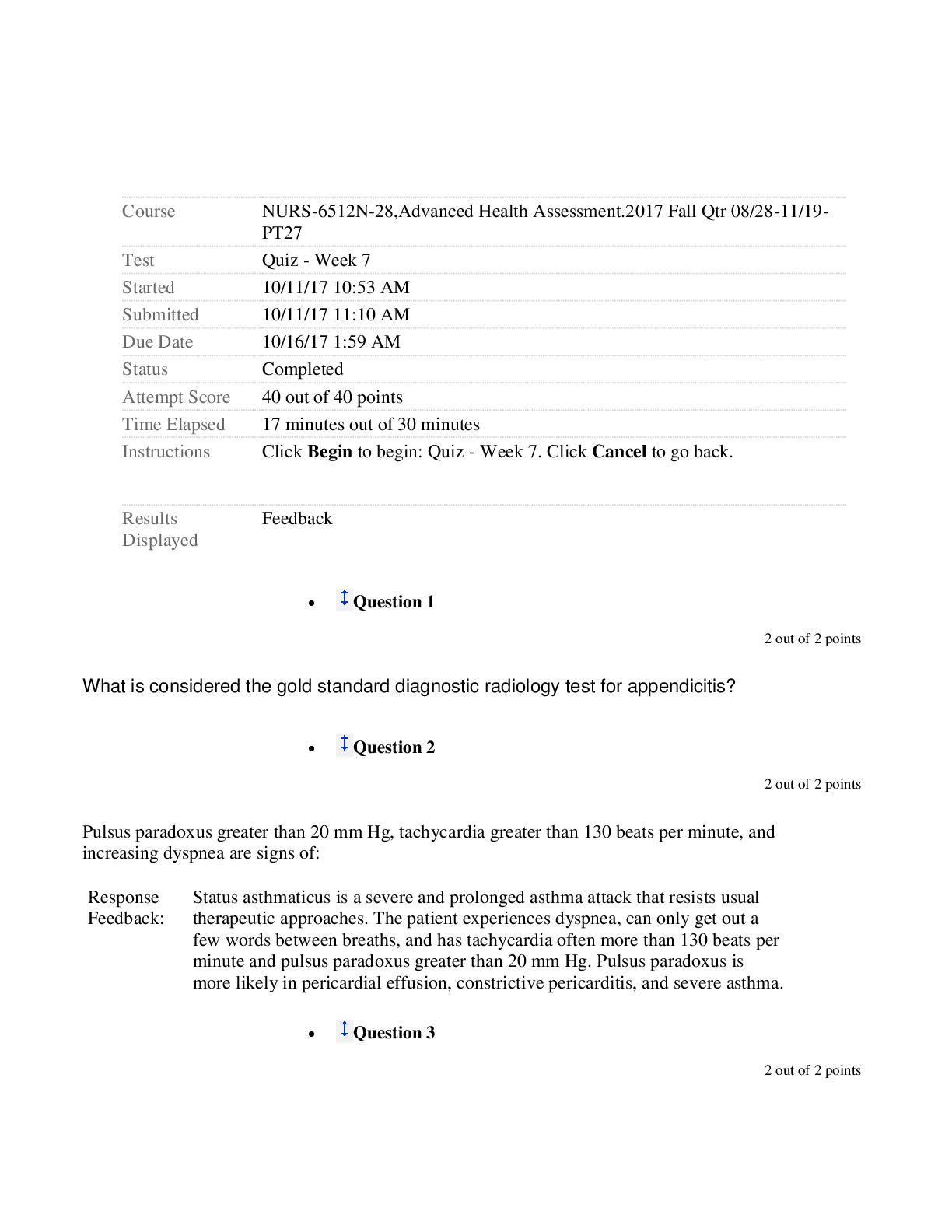



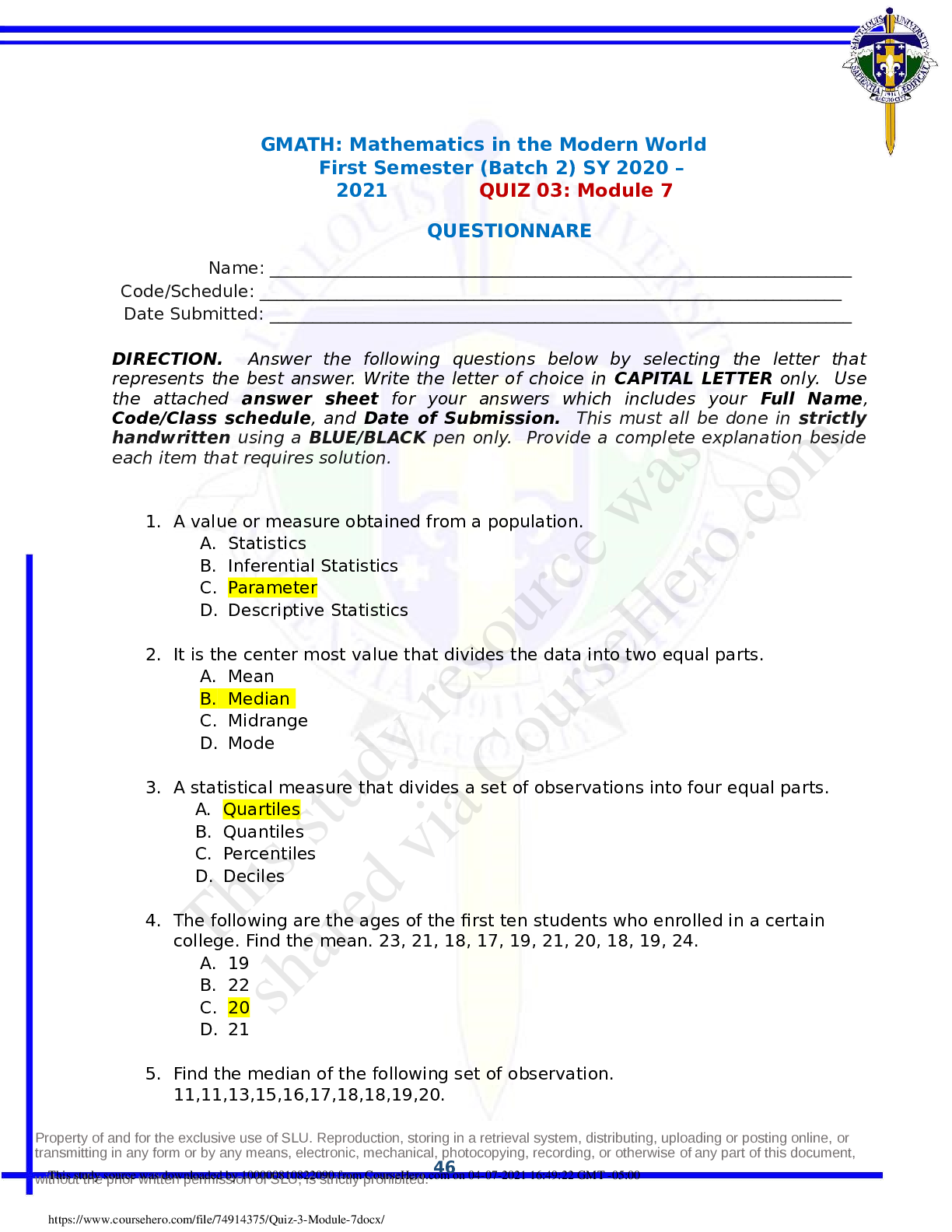



.png)










